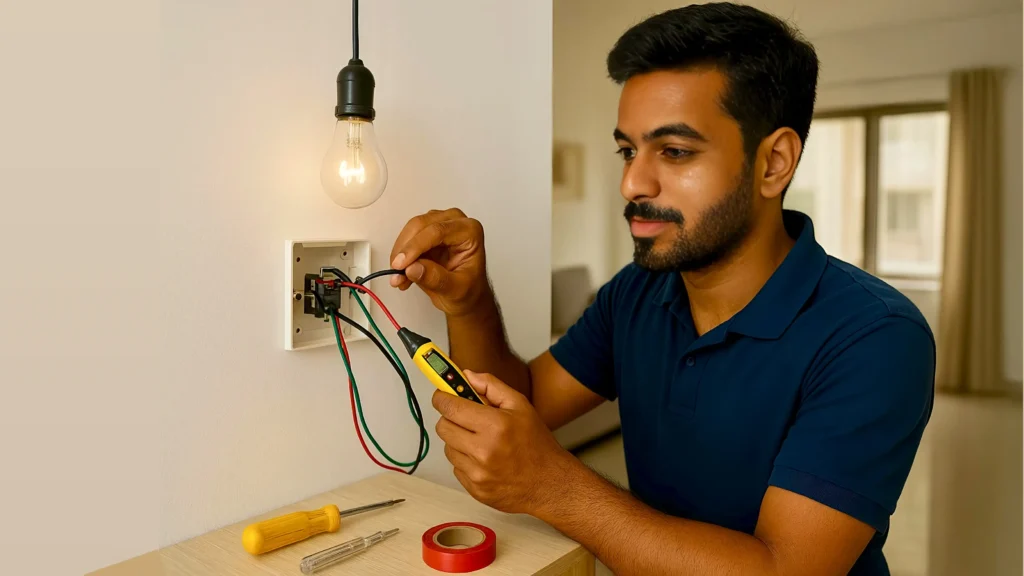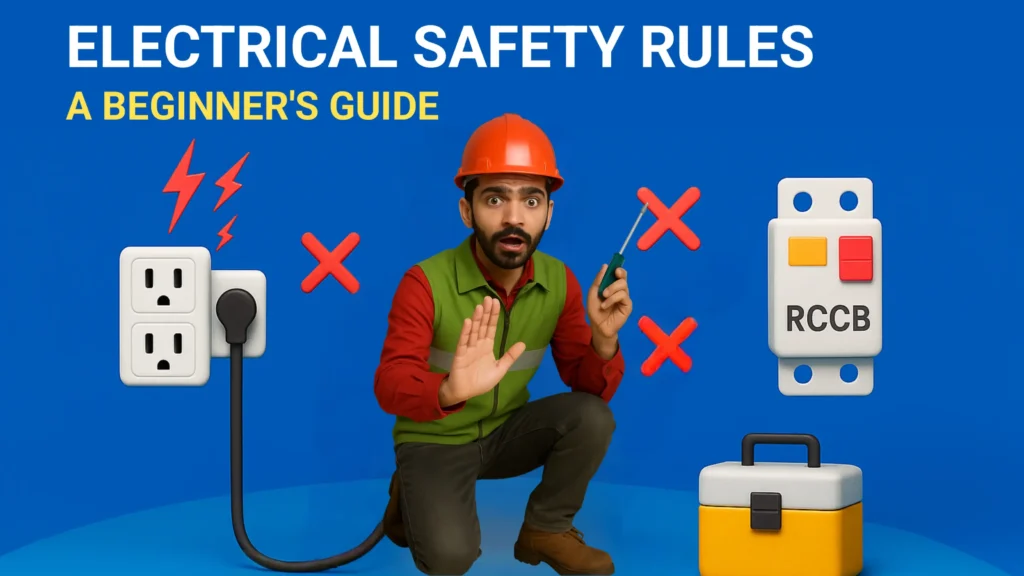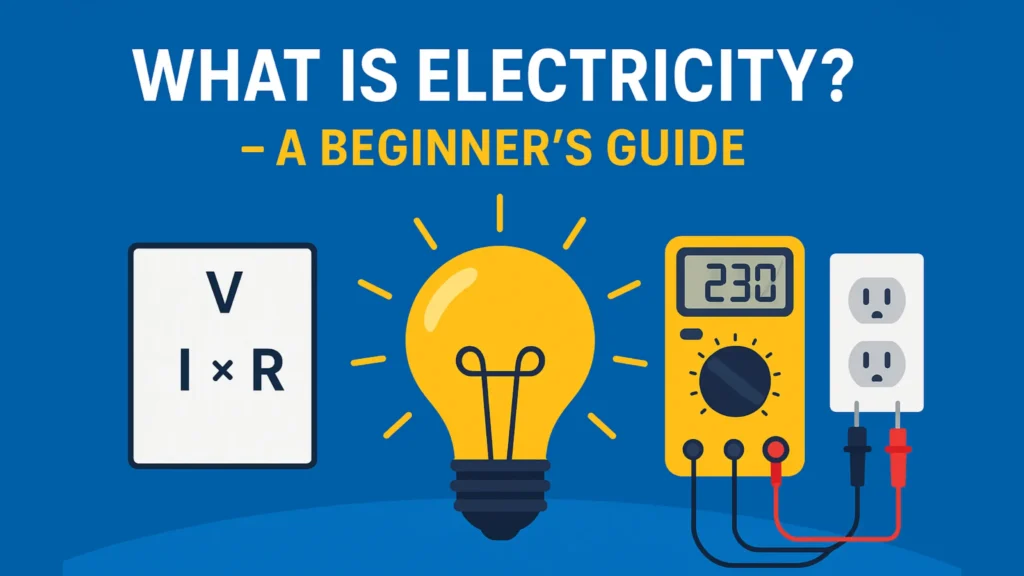
Part 3 of our Electrical Learning Series introduces beginners to the Basic Electrical Tools and Their Uses every DIYer and aspiring electrician should know. From screwdrivers and pliers to voltage testers and wire strippers, we’ll explain what each tool does, how to use it safely, and why it’s important for electrical work. This beginner-friendly guide also includes our recommended tools and kits (affiliate links) to help you build a reliable toolkit for Level 1 electrical projects.
Welcome to Part 3 of our Electrical Learning Series! – Basic Electrical Tools and Their Uses
If you’ve gone through Part 1 (What is Electricity?) and Part 2 (Electrical Safety Rules for Beginners), you’re now ready to explore the essential tools every beginner electrician or DIY enthusiast should know.
Working on electrical projects without the right tools is like trying to cook without utensils—it’s frustrating, risky, and rarely ends well. In this guide, we’ll introduce you to the most common electrical tools, their uses, and why they matter, so you can work smarter, safer, and more efficiently.
Basic Electrical Tools and Their Uses
Insulated Screwdrivers

Use: Tightening and loosening screws on outlets, switches, and terminals.
Why It’s Important: Electrical screws are often in live areas—an insulated handle prevents accidental shocks.
💡 Tip: Choose a set with both flat-head and Phillips heads.
🔗 Recommended: ⏬
Voltage Tester

Use: Checking if a circuit is live before working on it.
Why It’s Important: Prevents accidental contact with live wires—a top safety priority.
💡 Tip: A non-contact tester is safest for beginners.
🔗 Recommended: ⏬
Digital Multimeter

Use: Measuring voltage, current, and resistance.
Why It’s Important: Helps troubleshoot problems and verify safe working conditions.
💡 Tip: Look for a multimeter with auto-ranging for easier readings.
🔗 Recommended: Beginner Digital Multimeter – Amazon
Wire Strippers

Use: Removing insulation from wires without damaging the copper inside.
Why It’s Important: Clean wire stripping ensures solid connections and prevents faults.
💡 Tip: Adjustable strippers work for multiple wire sizes.
🔗 Recommended: Adjustable Wire Stripper – Amazon
Pliers (Needle-Nose & Lineman’s)

Use: Gripping, bending, cutting, and twisting wires.
Why It’s Important: Provides control when working in tight spaces and ensures strong connections.
💡 Tip: Keep both types—needle-nose for precision, lineman’s for heavy work.
🔗 Recommended: Pliers Set – Amazon
Cable Cutters

Use: Cutting wires and cables cleanly.
Why It’s Important: Clean cuts prevent frayed ends, making connections safer and easier.
💡 Tip: Avoid using regular scissors—they can damage the wire and be unsafe.
🔗 Recommended: Heavy-Duty Cable Cutters – Amazon
Electical Tape

Use: Insulating wire connections and repairs.
Why It’s Important: Protects against electrical leakage and short circuits.
💡 Tip: Always use high-quality, flame-retardant tape.
🔗 Recommended: Premium Electrical Tape – Amazon
Safety Gear

Use: Gloves, goggles, and insulated shoes.
Why It’s Important: Protection from sparks, shocks, and debris.
💡 Tip: Never skip safety gear—it’s your last line of defense.
🔗 Recommended: Electrical Safety Gear Kit – Amazon
Drill Machine (Optional for Beginners)

Use: Installing electrical boxes, panels, or running wires through walls.
Why It’s Important: Saves time and makes professional-quality installations possible.
💡 Tip: A cordless drill is more versatile for home use.
🔗 Recommended: Cordless Drill Machine – Amazon
Measuring Tape

Use: Measuring distances for cable runs and installations.
Why It’s Important: Precise measurements save time, money, and frustration.
💡 Tip: Choose one with both metric and imperial markings.
🔗 Recommended: Durable Measuring Tape – Amazon
Conclusion on Basic Electrical Tools and Their Uses
The right tools don’t just make electrical work easier—they make it safer. By starting with these Basic Electrical Tools and Their Uses, you’ll be equipped to handle simple projects confidently while protecting yourself from accidents.
Invest in quality tools now, and they’ll serve you for years to come. And remember—always follow the safety rules from Part 2 before starting any job.
⚡ If this guide helped you, share it with friends and check out the other parts of our Electrical Learning Series to keep building your skills.
⏬ Up Next in the Electrical Learning Series – Part 4
“Wiring Basics: Introduction to House Wiring” – Now that you know the essential tools and their uses, it’s time to learn how they come into action. In this next guide, we’ll walk you through the basics of house wiring, including types of wires, simple wiring connections, and beginner-friendly tips to get started safely and confidently.
Wiring Basics: Introduction to House Wiring

Part 2 – Electrical Safety Rules for Beginners

Part 1 – What is Electricity – A Beginner’s Guide

FAQs on Basic Electrical Tools and Their Uses
What is the first tool a beginner electrician should buy?
A voltage tester—because safety comes before all other work.
Can I use normal pliers instead of insulated pliers?
No—insulated pliers protect against accidental shocks.
Do I really need a multimeter as a beginner?
Yes—it’s essential for troubleshooting and confirming safe conditions.
What brand of tools is best for beginners?
Brands like Stanley, Bosch, and Klein Tools offer reliable beginner options.
nice series, very helpful
Pingback: Wiring Basics Introduction to House Wiring – Level 2 (Part 4) -
Pingback: 1-Way Switch Connection: Diagram, Step-by-Step Guide & Common Mistakes to Avoid - Home Fitting
Pingback: Electrical Safety Rules for Beginners – (Electrical Learning Series – Part 2) - Home Fitting